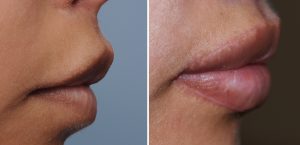Background: Synthetic injectable fillers have their origins in the use for lip augmentation. The desire for fuller lips by injections dates back to the 1980s and, while many different compositions of fillers have been subsequently used, they all can provide an immediate change in lip size albeit temporary. While the development of injectable fillers has progressed and longer-acting ones have been developed, no FDA-approved permanent augmentation filler has yet to be approved for the lips. (Silicone oil may be permanent but it is not FDA-approved)
While effective, lip filler injections are probably the least ‘enjoyable’ of all facial sites to inject. The lip has the greatest concentration of nerve fibers of any tissue on the face and, as a result, requires some form of topical anesthesia to treat for many patients. I found that the use of injection cannulas to help considerably with patient comfort and eliminates the need for any anesthesia.
While making the actual injections much more tolerable, their temporary effect is unavoidable. Some patients who have had repeated lip injections over the years talk about how they have become ‘resistant’ to the injections or their body metabolizes them rapidly getting effects that last less than four to six weeks. Regardless of whether their effects are short term or last as long as the manufacturer says, over time injectable filler costs can become prohibitive.
Case Study: This 24 year old female had received injectable filler injections to her upper and lower lips for over 5 years. Due to their cost she had now developed ‘injectable filler fatigue’ and wanted a permanent lip augmentation solution. Her last lip injection were done is months previously.

Her six week postoperative result showed well healed vermilion-cutaneous scar lines without any significant widening or hypertrophy.
Once injectable filler fatigue has occurred some patients are then ready to proceed with definitive vermilion advancements with a better acceptance of the scar risks.
Case Highlights:
1) Injectable filler fatigue occurs when one gets tired of the expense of pain of repeated treatments.
2) Injector filler fatigue is most likely to occur in the lips.
3) The one permanent lip augmentation procedure that affects corner to corner is the vermilion advancement.
Dr. Barry Eppley
Indianapolis, Indiana




